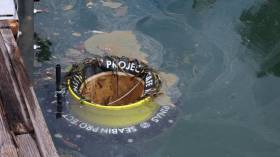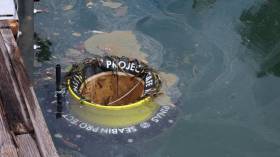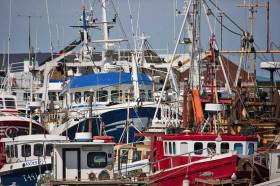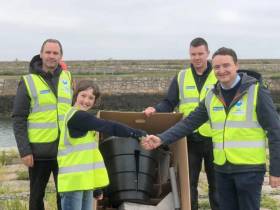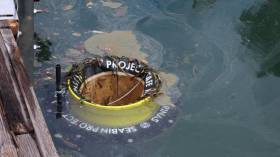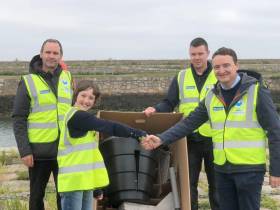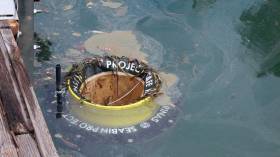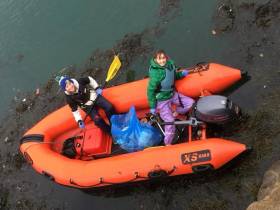Displaying items by tag: SeaBin
Funding Available for UK Seabin Installation Worth Over £5,000
The Seabin Project is providing funding for a Seabin and its installation in the UK, ideally in the London area to support cleaning up the capital’s waterways. This funding package is worth over £5,000.
An award-winning piece of technology, the Seabin acts as a floating rubbish bin, specifically designed to be installed in marinas, yacht clubs, inland waterways and harbours, or any calm body of water with access to electricity.
Applications for the funding are being accepted by the UK & Ireland Seabin supplier, Inland and Coastal Marina Systems (ICMS).
“We’re welcoming applications from credible projects and enthusiastic partners with locations in and around London that would benefit from the litter collecting capabilities of a Seabin,” says Bryan Stewart, from ICMS.
“This is a great opportunity for a charity, organisation or business to benefit from a very generous donation, helping to tackle the ongoing battle of waterborne waste in our rivers and harbours.
“We’re interested to hear from individuals or groups who can put forward a strong case for how a Seabin would help improve their local marine environment as well as help educate on the harm caused by plastic pollution.”
Made from recyclable materials, the Seabin sits in the water and moves up and down with the tide, collecting floating debris. Water is drawn in from the surface by a submersible water pump and passes through a fine mesh catch bag inside the Seabin.
To ensure optimum operation, a Seabin needs to be installed in a calm water location, within six metres of a mains power source as the pump plugs directly in either a 110V or 220V outlet.
Ideally, to manage variations in water height or tidal fluctuations, a Seabin is attached to an existing floating pontoon. As the funding only covers supply and installation of a Seabin, a resource to manage the everyday running of the Seabin, including regular emptying and occasional maintenance, needs to be readily available.
To apply for the funding from the Seabin Project, interested parties should contact Bryan Stewart via [email protected] with the contact details of their organisation, and an outline of where the Seabin would be installed and the benefits that it would bring in the local area.
For more information on the Seabin click here
Howth Harbour Is Getting Its Own Seabin Next Week
A campaign to raise funds for Howth Harbour’s first Seabin has been successful, and the first device will be switched on at a special event next Wednesday morning (21 August).
Earlier this year, local man Rowan Byrne launched a crowdfunding drive to pay for the installation of the surface water cleaning device that has already made a big difference in Dun Laoghaire thanks to the sterling efforts of young marine litter campaigner Flossie Donnelly.
Byrne has also been backed by his employer Mott MacDonald and Howth’s Harbour Master in his own efforts, and harbour authorities will maintain the Seabin that will be installed at the passenger vessel ferry pontoon opposite Aqua restaurant.
The Seabin is essentially a floating bucket with a pump that sucks in debris from the surface and traps it for later collection.
But the device’s simplicity belies its effectiveness, as a single Seabin as the potential to collect as many as 20,000 plastic bottles or more than 80,000 plastic bags from the water each year.
“Everyone knows just how important the sea and the marine life in there is to us,” said Harbour Master Harold McLoughlin. “We hope this Seabin will have a big impact on the amount of rubbish floating around in the local area.”
Mid & East Antrim Votes For Seabins To Clean Up Coastline
Mid and East Antrim Borough Council has voted unanimously to approve the installation of water-cleaning Seabins along the coastline north of Belfast Lough, as the Larne Times reports.
Harbours and marinas from Carrickfergus to Carnlough are now expected to benefit from the revolutionary water-cleaning devices — a single one of which has the potential to collect half a tonne of rubbish, or more than 80,000 plastic bags, from the water surface each year.
As reported by the Belfast Telegraph last September, Ards and North Down councillors were planning to bring in 10 Seabins to help clean up harbours and marinas around the peninsula.
In the Republic, the latest Seabins may soon come to Howth thanks to a local crowdfunding campaign that follows young anti-litter figurehead Flossie Donnelly’s successful awareness and fundraising efforts in Dun Laoghaire Harbour.
Crowdfunding Campaign Launched For Howth’s First Seabins
#Seabin - Howth will be the latest Irish port to benefit from a revolutionary device designed to clean up harbour and marina waters.
Independent.ie reports that local man Rowan Byrne has launched a crowdfunding campaign to pay for the installation of two Seabins in the north Co Dublin harbour.
Byrne notes how more and more people at home and beyond are discovering Howth’s natural beauty, but that this also means “more and more plastics, nano, micro and macro plastics are seen floating on the waters surface in the harbour”.
One solution to this problem is the Seabin — a floating bucket with a pump that sucks in surface debris and traps it for collection.
A single device has the potential to collect as many as 20,000 plastic bottles or more than 80,000 plastic bags each year.
Byrne’s efforts follow those of young marine litter campaigner Flossie Donnelly, who recently presented the National Yacht Club with its own Seabin — the second such device in Dun Laoghaire Harbour after her own crowdfunded bin was installed last summer.
Ards and North Down Borough Council is also seeking to procure a number of Seabins to help clean up the coastline of the Ards Peninsula around Strangford Lough.
#Seabin - Five months after local coastal litter campaigner Flossie Donnelly saw the installation of Dun Laoghaire Harbour’s first Seabin, the enterprising youth has presented the National Yacht Club with its own water-cleaning device.
According to the Dun Laoghaire waterfront club, 12-year-old Flossie’s fundraising efforts for Ireland’s first ever Seabin were so inspiring that the company behind the project donated a second device for free.
The Seabin is essentially a floating bucket with a pump that sucks in surfacedebris and traps it for collection. A single device has the potential to collect as many as 20,000 plastic bottles or more than 80,000 plastic bags each year.
Flossie’s Seabin initiative has since won some influential support from NYC stalwart Annalise Murphy, who raced around the world on board Turn the Tide on Plastic in the most recent Volvo Ocean Race.
The National Yacht Club has more on the story HERE.
Seabins To Clean Up Ards Peninsula In Council Plans
#Seabin - Ards and North Down Borough Council wants to bring in the Seabin to help clean up the coastline of the Ards Peninsula, as the Belfast Telegraph reports.
The council plans to purchase 10 of the devices — which capture floating debris in harbours and marinas — in what’s being touted as a first for Northern Ireland.
Earlier this year, Dun Laoghaire Harbour in Dublin saw the installation of its first Seabin thanks to the campaigning efforts of local girl Flossie Donnelly.
It’s hoped that the move by Ards councillors will see further take up around the Northern Irish coast.
The Belfast Telegraph has more on the story HERE.
Flossie Welcomes First Seabin For Dun Laoghaire Harbour
#Seabin - Young coastal litter crusader Flossie Donnelly is celebrating the installation of Dun Laoghaire Harbour’s first Seabin after a successful fundraising campaign.
The 11-year-old was on hand at noon today (Tuesday 22 May) to see the first of two such devices submerged into the harbour’s waters, where they will quietly trap floating debris on the surface that has become the scourge of regular harbour users.
As previously reported on Afloat.ie, a single Seabin has the potential to collect as many as 83,000 plastic bags or 20,000 plastic bottles every year.
Enterprising Flossie has been campaigning for a cleaner Dun Laoghaire and Dublin Bay since last year, when she began her regular beach cleaning meet-ups in Sandycove.
“When Flossie first approached us, she already knew what she wanted, to install Ireland’s first Seabin and was well underway with her fundraising efforts,” said Dun Laoghaire Harbour Company operations manager Tim Daly. “Her resolve inspired us to whatever we could to help her out.”
Seabin distributor Inland and Coastal Marina Systems also expressed their delight to be a part of the project with Flossie, who will be grand marshall of the first March for the Ocean in Dun Laoghaire on Saturday 9 June.
Flossie Crowdfunding For Seabin In Dun Laoghaire Harbour
#Seabin - Coastal litter crusader Flossie Donnelly has raised hundreds of euro in a crowdfunding campaign to procure a Seabin water cleaning device for Dun Laoghaire Harbour.
The Seabin is simple but remarkably effective, essentially a floating rubbish bin with a pump that traps floating debris — and which has the potential to collect as many as 83,000 plastic bags or 20,000 plastic bottles a year.
Floating rubbish in Dun Laoghaire’s waters and surrounds has been an issue for years, and prompted ambitious Flossie to start a regular beach and harbour clean-ups in South Dublin Bay last summer.
As previously reported on Afloat.ie, the youngster soon attracted a dedicated group of volunteers inspired by the 10-year-old’s drive.
But more could be done with the help of an automated device like the Seabin, for which Flossie also held a fundraising table quiz in Sandycove last November.
As of this morning (Wednesday 31 January), Flossie has raised €650 towards her €3,000 goal. Find out more about the campaign on its GoFundMe page HERE.
How One Girl Is Leading The Fight Against Litter In Dublin Bay
#DublinBay - Litter in the water is a longstanding issue in Dun Laoghaire and Sandycove — but one local schoolgirl has taken it upon herself to do something about it.
Ten-year-old Flossie Donnelly started this past summer calling for volunteers to help clean up the sea shore at Sandycove every Friday evening, even designing her own poster to spread the word on social media and around the neighbourhood.
On her blog, Flossie writes that she was “really sad” that no one came to her first clean-up.
But a meeting at the Forty Foot the next day with county councillor Cormac Devlin led to the word spreading further in the local press.
“It’s very unusual that a child of her age approached an adult and a politician at that. That she is so environmentally aware is wonderful,” Cllr Devlin told the Dublin People in August.
By the end of the summer, Flossie was in charge of her own crew of volunteers helping to remove plastic debris that is dangerous to Dublin Bay’s marine life and local boaters alike.
Despite the shorter days and colder weather of late autumn and winter, Flossie is still leading regular coastal clean-ups and making friends along the way — including an Australian girl whose message she found in a bottle.
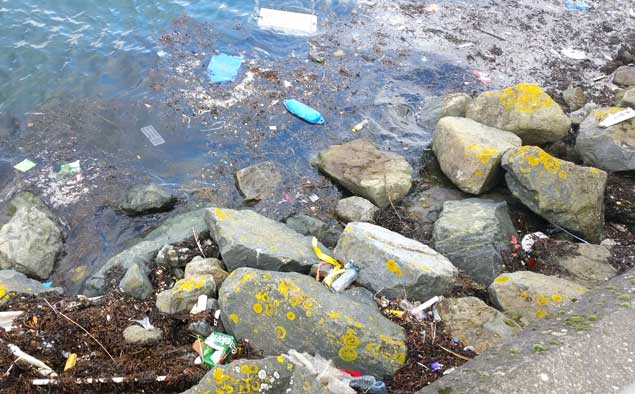 Marine debris in Dun Laoghaire
Marine debris in Dun Laoghaire
More recently, Flossie was out on a RIB in Dun Laoghaire Harbour to clean up the breakwaters — filling three boats with rubbish and doing “a week’s work in a day”, according to Dun Laoghaire Coast Guard, who praised the “inspirational” girl for her efforts.
But the ambitious youngster isn’t stopping there, with plans to raise money for the installation of a Seabin automated cleaning system for the harbour, in what would be a first for Ireland.
Previously highlighted during Afloat.ie’s Rio Olympics coverage last year, the Seabin device has the potential to collect as many as 83,000 plastic bags or 20,000 plastic bottles each year.
That amounts to half a tonne of plastic annually, from visible debris to micro-plastics that threaten our protected species.
Britain’s first Seabin was recently installed at the pontoon of America’s Cup team Land Rover BAR in Portsmouth as part of a project to restore populations of oysters in the Solent.
Flossie and her beach cleaning squad will be hosting a table quiz at Fitzgerald’s Pub in Sandycove next Thursday 30 November to raise funds towards Dublin Bay’s first Seabin. For details see Flossie’s website HERE.
New Automated Marina Cleaning System Hits Crowdfunding Goal, Could Be In Use At Rio 2016
#Rio2016 - A smart new system for automatic cleaning of marinas has reached its crowdfunding goal with days to spare – and could soon be employed at the Olympic Games.
According to Sail World, the Rio 2016 organisers are among those who have expressed interest in and voiced support for the SeaBin, an automated rubbish bin designed to collect floating debris and oil from busy marina berths.
The project, launched by Australians Pete Ceglinski and Andrew Turton, has surpassed its $230,000 by more than $17,000 with four days to go as of today (Monday 4 January).
It means the project can now move on to the next stage, working with a French manufacturer to develop a new generation of SeaBins made from mostly recycles plastics.
And it's possible we might see the first SeaBins in action at the Rio sailing villages this summer – although there's not that can be done about viral contaminants in Guanabara Bay, as previously reported on Afloat.ie.


























